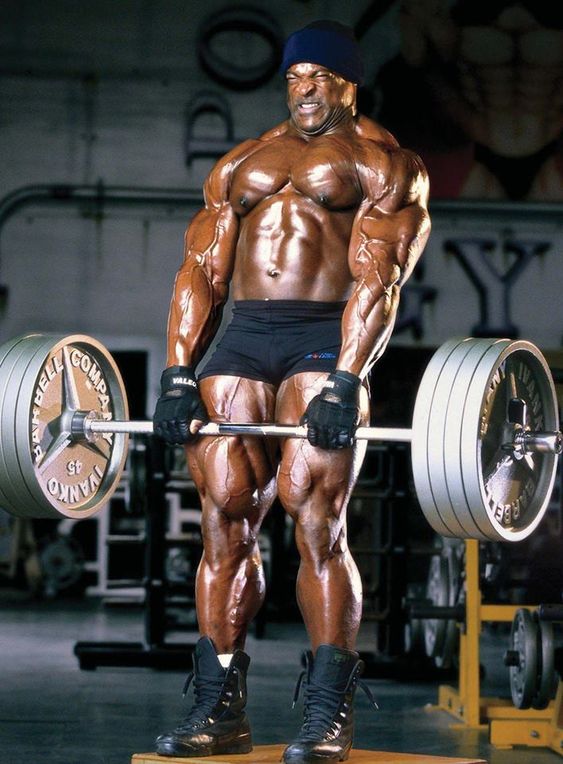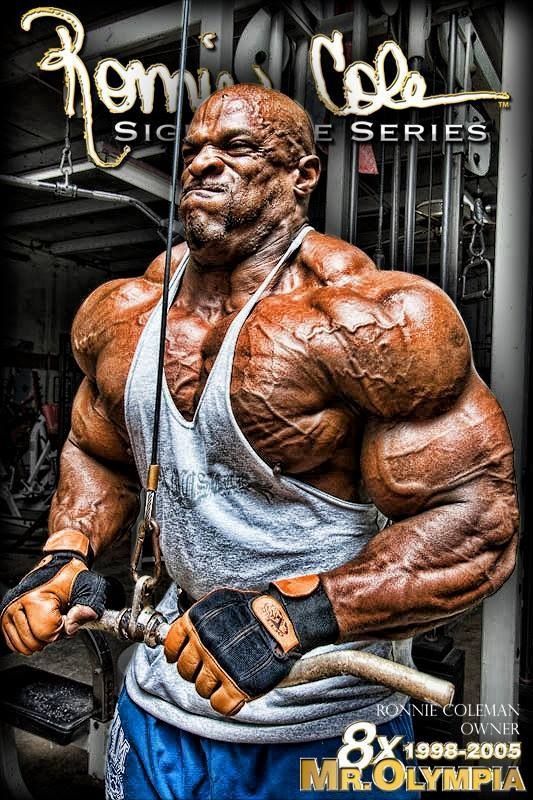Ronnie Coleman, often hailed as one of the greatest bodybuilders of all time, dominated the bodybuilding world with an unprecedented eight Mr. Olympia titles.
Known for his immense strength, incredible work ethic, and charismatic personality, Ronnie Coleman’s training techniques have become legendary in the fitness community.
His famous quote, “Everybody wants to be a bodybuilder, but nobody wants to lift no heavy ass weights,” encapsulates his philosophy and dedication to lifting heavy and training hard.
In this article, we will delve into the top two training techniques Ronnie Coleman used to secure his place at the pinnacle of bodybuilding: progressive overload and optimal range of motion.

Progressive Overload: The Cornerstone of Ronnie Coleman’s Training
Understanding Progressive Overload
Progressive overload is a fundamental principle of strength training and muscle growth.
It involves gradually increasing the stress on the muscles during exercise to stimulate muscle hypertrophy and strength gains.
This can be achieved by increasing the weight lifted, the number of repetitions, the intensity, or the frequency of training sessions.

Ronnie Coleman’s Approach to Progressive Overload
Ronnie Coleman’s training regimen was a testament to the effectiveness of progressive overload.
Throughout his career, he consistently pushed the boundaries of his physical capabilities by lifting increasingly heavier weights.
This relentless pursuit of strength not only built his massive physique but also set new standards in the bodybuilding world.
Ronnie Coleman’s training videos over the years showcase his commitment to progressive overload.
Whether it was his legendary 800-pound squats and deadlifts or his mind-boggling 2,300-pound leg presses, Ronnie Coleman continually challenged his muscles with heavier loads.
His philosophy was simple yet effective: to get bigger and stronger, you must lift heavier weights over time.

Practical Application: Incorporating Progressive Overload into Your Routine Coleman
To incorporate progressive overload into your training, follow these steps:
- Start with a Baseline: Determine your current strength levels by performing a series of exercises with weights you can lift for 8-12 repetitions with good form.
- Gradual Increases: Aim to increase the weight by small increments (2.5-5 pounds) every week or every other week.
- Track Your Progress: Keep a training log to monitor your progress and ensure that you are consistently challenging your muscles.
- Variety in Overload: Besides adding weight, you can also increase the number of sets, reps, or the frequency of your workouts to continue progressing.
- Recovery: Ensure you get adequate rest and recovery to allow your muscles to adapt and grow stronger.
Optimal Range of Motion: Maximizing Muscle Engagement
The Importance of Range of Motion

Range of motion (ROM) refers to the distance and direction a joint can move between the flexed and extended positions.
Training within the optimal range of motion ensures that the muscles are fully engaged and stimulated throughout the exercise.
This is crucial for achieving maximum muscle growth and preventing injuries.
Ronnie Coleman’s Mastery of Range of Motion
Joe Bennett, also known as the ‘Hypertrophy Coach’, highlighted Ronnie Coleman’s adept use of range of motion in his training.
Ronnie Coleman’s technique involved using the full range of motion for each exercise, ensuring that his muscles were under constant tension and worked to their full potential.
For example, during his incline presses, Ronnie Coleman focused on lowering the weight until his upper arms were roughly parallel to the ground, which is the point of peak shoulder joint torque.
By working within this range, he maximized muscle activation and growth. Additionally, he often went slightly deeper when his range of motion and the exercise allowed, further enhancing the muscle-building stimulus.

Practical Application: Optimizing Your Range of Motion
To optimize your range of motion in training, consider the following tips:
- Full Range of Motion: Perform exercises through their full range of motion to ensure maximum muscle engagement. Avoid partial reps unless specifically training for strength in a particular phase of the movement.
- Proper Form: Maintain proper form and technique to avoid injuries and ensure that the target muscles are being effectively worked.
- Flexibility and Mobility: Incorporate flexibility and mobility exercises into your routine to improve your range of motion and overall performance.
- Controlled Movements: Focus on controlling the eccentric (lowering) phase of the lift and pausing briefly at the bottom of the movement before the concentric (lifting) phase.
- Listen to Your Body: Adjust the range of motion if you experience discomfort or pain in your joints, and consult with a fitness professional if needed.
The Legacy of Ronnie Coleman’s Training Techniques
An Unmatched Work Ethic

Ronnie Coleman’s work ethic is legendary. His dedication to training was evident in every aspect of his routine, from his relentless pursuit of heavier weights to his meticulous attention to form and range of motion.
Ronnie Coleman’s approach to training was not just about lifting heavy weights; it was about lifting them correctly and consistently.
The Role of Intensity in Training

Ronnie Coleman’s training sessions were characterized by their intensity. He believed in pushing his body to its limits and beyond.
This intensity was a key factor in his success and is something that aspiring bodybuilders can learn from.
While it is important to lift heavy and train hard, it is equally important to do so with intensity and focus.
Training Through Adversity
Even after retiring from competitive bodybuilding, Ronnie Coleman’s dedication to training has not waned.
Despite facing significant physical challenges, including multiple surgeries and mobility issues, Ronnie Coleman continues to train regularly.
His perseverance and positive attitude in the face of adversity serve as an inspiration to many in the fitness community.
Implementing Ronnie Coleman’s Techniques in Your Training
Creating a Structured Training Plan

To effectively implement Ronnie Coleman’s training techniques, it is essential to create a structured training plan.
This plan should include progressive overload and exercises that utilize the optimal range of motion.
Additionally, incorporating elements of Ronnie Coleman’s intensity and work ethic can help maximize your training outcomes.
Sample Training Split

Here is a sample training split that incorporates Ronnie Coleman’s principles:
- Day 1: Chest and Triceps
- Bench Press: 4 sets of 8-12 reps
- Incline Dumbbell Press: 4 sets of 8-12 reps
- Chest Flyes: 3 sets of 10-15 reps
- Tricep Dips: 3 sets of 8-12 reps
- Tricep Pushdowns: 3 sets of 10-15 reps
- Day 2: Back and Biceps
- Deadlifts: 4 sets of 6-10 reps
- Bent Over Rows: 4 sets of 8-12 reps
- Pull-Ups: 3 sets of max reps
- Bicep Curls: 3 sets of 10-15 reps
- Hammer Curls: 3 sets of 10-15 reps
- Day 3: Legs
- Squats: 4 sets of 8-12 reps
- Leg Press: 4 sets of 10-15 reps
- Leg Curls: 3 sets of 10-15 reps
- Calf Raises: 4 sets of 15-20 reps
- Day 4: Shoulders
- Shoulder Press: 4 sets of 8-12 reps
- Lateral Raises: 3 sets of 10-15 reps
- Front Raises: 3 sets of 10-15 reps
- Rear Delt Flyes: 3 sets of 10-15 reps
- Day 5: Rest
- Day 6: Repeat Cycle
Nutrition and Recovery

In addition to training, nutrition, and recovery play a crucial role in muscle growth and overall performance.
Ronnie Coleman was known for his disciplined approach to diet, ensuring that he consumed enough protein, carbohydrates, and fats to support his intense training regimen.
Adequate sleep, hydration, and supplementation are also essential components of a successful training program.
The Future of Bodybuilding: Learning from Ronnie Coleman
Ronnie Coleman’s training techniques are rooted in the fundamentals of bodybuilding.
While the fitness industry continues to evolve with new equipment and training methods, the core principles of progressive overload and optimal range of motion remain timeless.
Aspiring bodybuilders can learn from Ronnie Coleman’s example and focus on mastering these fundamentals to achieve their goals.
